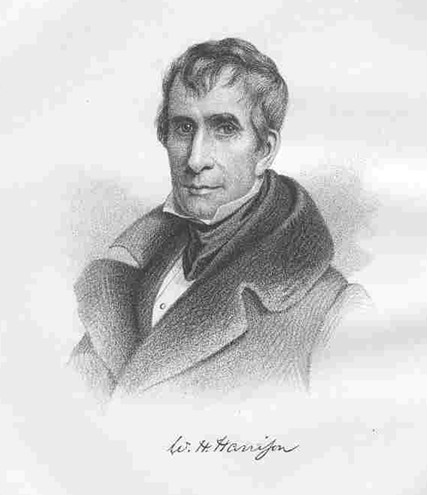
|
Carroll County IAGenWeb |
of
GREENE and CARROLL COUNTIES, IOWA
The Lewis Publishing Company, 1887
Transcribed by Sharon Elijah January 8, 2021

|
Carroll County IAGenWeb |
Transcribed by Sharon Elijah January 8, 2021
 |
WILLIAM HENRY HARRISON, the ninth President of the United States, 1831, was born February 9, 1773, in Charles County, Virginia, at Berkeley, the residence of this father, Governor Benjamin Harrison. He studied at Hampden, Sidney College, with a view of entering the medical profession. After graduation he went to Philadelphia to study medicine under the instruction of Dr. Rush.George Washington was then President of the United States. The Indians were committing fearful ravages on our Northwestern frontier. Young Harrison, either lured by the love of adventure, or moved by the sufferings of families exposed to the most horrible outrages, abandoned his medical studies and entered the army, having obtained a commission of ensign from President Washington. The first duty assigned him was to take a train of pack-horses bound to Fort Hamilton, on the Miami River, about forty miles from Fort Washington. He was soon promoted to the rank of Lieutenant, and joined the army which Washington had placed under the command of General Wayne to prosecute more vigorously the war with the Indians. Lieutenant Harrison received great commendation from his commanding officer, and was promoted to the rank of Captain, and placed in command at Fort Washington, now Cincinnati, Ohio.
About this time he married a daughter of John Cleves Symmes, one of the frontiersmen who had established a thriving settlement on the bank of the Maumee.
In 1797 Captain Harrison resigned his commission in the army and was appointed Secretary of the Northwest Territory, and ex-officio Lieutenant-Governor, General St. Clair being then Governor of the Territory. At that time the law in reference to the disposal of the public lands was such that no one could purchase in tracts less than 4,000 acres. Captain Harrison, in the face of violent opposition, succeeded in obtaining so much of a modification of this unjust law that the land was sold in alternate tracts of 640 and 320 acres. The Northwest Territory was then entitled to one delegate in Congress, and Captain Harrison was chose to fill that office. In 1800 he was appointed Governor of Indiana Territory and soon after of Upper Louisiana. He was also Superintendent of Indian Affairs, and so well did he fulfill these duties that he was four times appointed to this office. During his administration he effected thirteen treaties with the Indians, by which the United States acquired 60,000,000 acres of land. In 1804 he obtained a cession from the Indians of all the land between the Illinois River and the Mississippi.
In 1812 he was made Major-General of Kentucky militia and Brigadier-General in the army, with the command of the Northwest frontier. In 1813 he was made Major-General, and as such won much renown by the defense of Fort Meigs, and the battle of the Thames, October 5, 1813. In 1814 he left the army and was employed in Indian affairs by the Government.
In 1816 General Harrison was chosen a member of the National House of Representatives to represent the district of Ohio. In the contest which preceded his election he was accused of corruption in respect to the commissariat of the army. Immediately upon taking his seat, he called for an investigation of the charge. A committee was appointed, and his vindication was triumphant. A high compliment was paid to his patriotism, disinterestedness and devotion to the public service. For these services a gold medal was presented to him with the thanks of Congress.
In 1819 he was elected to the Senate of Ohio, and in 1824, as one of the Presidential electors of that State, he gave his vote to Henry Clay. In the same year he was elected to the Senate of the United States. In 1828 he was appointed by President Adams minister plenipotentiary to Colombia, but was recalled by General Jackson immediately after the inauguration of the latter.
Upon his return to the United States, General Harrison retired to his farm at North Bend, Hamilton County, Ohio, sixteen miles below Cincinnati, where for twelve years he was clerk of the County Court. He once owned a distillery, but perceiving the sad effects of whisky upon the surrounding population, he promptly abandoned his business at great pecuniary sacrifice.
In 1836 General Harrison was brought forward as a candidate for the Presidency. Van Buren was the administration candidate; the opposite party could not unite, and four candidates were brought forward. General Harrison received seventy-three electoral votes without any general concert among his friends. The Democratic party triumphed and Mr. Van Buren was chosen President. In 1839 General Harrison was again nominated for the Presidency by the Whigs, at Harrisburg, Pennsylvania, Mr. Van Buren being the Democratic candidate. General Harrison received 234 electoral votes against sixty for his opponent. This election is memorable chiefly for the then extraordinary means employed during the canvass for popular votes. Mass meetings and processions were introduced, and the watchwords “log cabin” and “hard cider” were effectually used by the Whigs, and aroused a popular enthusiasm.
A vast concourse of people attended his inauguration. His address on that occasion was in accordance with his antecedents, and gave great satisfaction. A short time after he took his seat, he was seized by a pleurisy-fever, and after a few days of violent sickness, died April 4, just one short month after his inauguration. His death was universally regarded as one of the greatest of National calamities. Never, since the death of Washington, were there, throughout one land, such demonstrations of sorrow. Not one single spot can be found to sully his fame; and through all ages Americans will pronounce with love and reverence the name of William Henry Harrison.
~ * ~ * ~ * ~ * ~